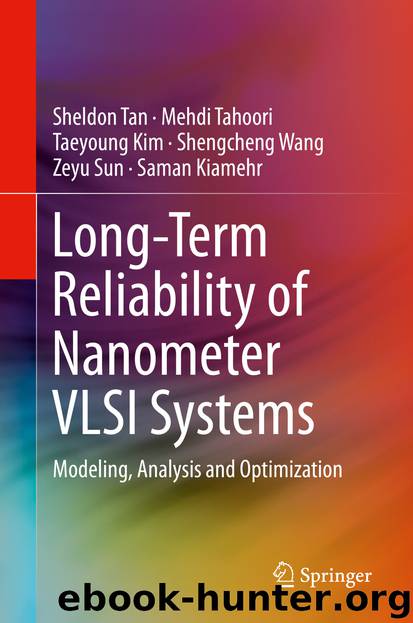Long-Term Reliability of Nanometer VLSI Systems by Sheldon Tan & Mehdi Tahoori & Taeyoung Kim & Shengcheng Wang & Zeyu Sun & Saman Kiamehr

Author:Sheldon Tan & Mehdi Tahoori & Taeyoung Kim & Shengcheng Wang & Zeyu Sun & Saman Kiamehr
Language: eng
Format: epub
ISBN: 9783030261726
Publisher: Springer International Publishing
10.3.4 Time Complexity Analysis
It has been proved that MILP problems are NP hard. Though branch and bound techniques can be used to solve the problem, the time complexity is not easy to analyze as we use commercial CPLEX as the solver. For the Q-learning, each value iteration can be performed in O(|A||S|2) steps, or faster if there is sparsity in the transition function (where A is a number of actions and S is a number of states). In practice, policy iteration converges in fewer iterations than value iteration, and there is no known tight worst-case bound available [34]. As a result, we report the running CPU times of Q-learning and MILP in our experiments with more p-states in Table 10.3 in Sect. 10.4 to compare the time complexities of the two methods. We further remark that it is rather difficult to fairly compare CPU times for these two optimization methods as the Q-learning was running on Python, whereas the MILP was running on commercial CPLEX Optimizer. Nevertheless, the numerical results still show that MILP has much higher computation cost than the Q-learning method. Table 10.3Elapsed CPU time to solve the proposed Q-learning and MILP problems [31]
Download
This site does not store any files on its server. We only index and link to content provided by other sites. Please contact the content providers to delete copyright contents if any and email us, we'll remove relevant links or contents immediately.
Linux Device Driver Development Cookbook by Rodolfo Giometti(3957)
Embedded Programming with Modern C++ Cookbook by Igor Viarheichyk(3785)
Implementing Cellular IoT Solutions for Digital Transformation by Dennis McCain(3704)
Embedded Linux Development Using Yocto Project - Third Edition by Otavio Salvador & Daiane Angolini(3553)
TinyML Cookbook by Gian Marco Iodice(3471)
Simplifying 3D Printing with OpenSCAD by Colin Dow(2861)
TinyML Cookbook by Gian Marco Iodice & Ronan Naughton(2623)
Fusion 360 for Makers by Lydia Sloan Cline(2231)
Networking A Beginner's Guide by Bruce Hallberg(2228)
Hands-On Linux for Architects by Denis Salamanca(2073)
But How Do It Know? by J. Clark Scott(2039)
Computers For Seniors For Dummies by Nancy C. Muir(2023)
Raspberry Pi and MQTT Essentials by Dhairya Parikh(1980)
Arduino Project Handbook, Volume 2: 25 Simple Electronics Projects for Beginners by Geddes Mark(1963)
9781803246888-ENHANCING DEEP LEARNING WITH BAYESIAN INFERENCE by Unknown(1918)
Hack and HHVM by Owen Yamauchi(1904)
31 Days Before Your CompTIA A+ Exams (Shanette Luellen's Library) by Benjamin Patrick Conry(1878)
MicroPython Projects by Jacob Beningo(1768)
Hands-On Internet of Things with MQTT by Tim Pulver(1730)
